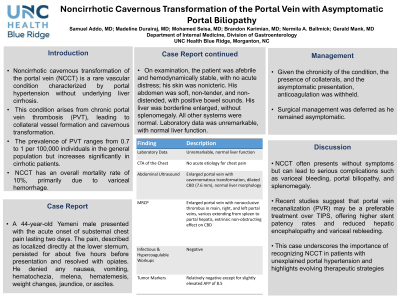Monday Poster Session
Category: Liver
P3030 - Noncirrhotic Cavernous Transformation of the Portal Vein With Asymptomatic Portal Biliopathy
Monday, October 28, 2024
10:30 AM - 4:00 PM ET
Location: Exhibit Hall E

Has Audio

Samuel Addo, MD
UNC Health Blue Ridge
Morganton, NC
Presenting Author(s)
Samuel Addo, MD, Madeline Durairaj, MD, Mohamed O. Seisa, MD, Brandon Karimian, MD, Nermila A. Ballmick, , Gerald Mank, MD
UNC Health Blue Ridge, Morganton, NC
Introduction: Noncirrhotic cavernous transformation of the portal vein (NCCT) is a rare vascular condition characterized by portal hypertension without underlying liver cirrhosis. This condition arises from chronic portal vein thrombosis (PVT), leading to collateral vessel formation and cavernous transformation. PVT prevalence ranges from 0.7 to 1 per 100,000 individuals in the general population but increases significantly in cirrhotic patients. NCCT has an overall mortality rate of 10% primarily due to variceal hemorrhage.
Case Description/Methods: A 44-year-old Yemeni male presented with acute onset of substernal chest pain of two days duration. The pain, described as localized directly at the lower sternum, without identifiable triggers persisted for about five hours before presentation and resolved with opiates. He denied any nausea, vomiting, hematochezia, melena, hematemesis, weight changes, jaundice, and ascites.
On examination, the patient was afebrile, hemodynamically stable with no acute distress, and his skin was nonicteric. His abdomen was soft, non-tender, nondistended with positive bowel sounds. His liver was borderline enlarged without splenomegaly. All other system were normal. Laboratory data was unremakable with normal liver function.
CTA of the chest revealed no acute etiology for chest pain. Abdominal ultrasound showed enlarged portalvein with cavernomatous transformation, dilated CBD measuring 7.6 mm and normal liver morphology. MRCP showed enlarged portal vein with nonocclusive thrombus in the main, right, and left portal vein with extension into the superior mesenteric vein. Extensive varices were seen extending from spleen to portal hepatis causing extrinsic non-obstructing effect on the CBD
Infectious and hypercoagulable workup were negative. Tumor markers were relatively negative except slightly elevated AFP of 8.5. Given the chronicity of condition with presence of collaterals and asymptomatic presentation, anticoagulation was held. Surgical management deferred as he was asymptomatic.
Discussion: NCCT often presents without symptoms but can lead to serious complications such as variceal bleeding, portal biliopathy and splenomegaly. Recent studies suggest portal vein recanalization (PVR) may be preferable treatment over TIPS, offering higher stent patency rates, reduced hepatic encephalopathy and variceal rebleeding. This case underscores the importance of recognizing NCCT in patients with unexplained portal hypertension and highlights evolving therapeutic strategies.
Disclosures:
Samuel Addo, MD, Madeline Durairaj, MD, Mohamed O. Seisa, MD, Brandon Karimian, MD, Nermila A. Ballmick, , Gerald Mank, MD. P3030 - Noncirrhotic Cavernous Transformation of the Portal Vein With Asymptomatic Portal Biliopathy, ACG 2024 Annual Scientific Meeting Abstracts. Philadelphia, PA: American College of Gastroenterology.
UNC Health Blue Ridge, Morganton, NC
Introduction: Noncirrhotic cavernous transformation of the portal vein (NCCT) is a rare vascular condition characterized by portal hypertension without underlying liver cirrhosis. This condition arises from chronic portal vein thrombosis (PVT), leading to collateral vessel formation and cavernous transformation. PVT prevalence ranges from 0.7 to 1 per 100,000 individuals in the general population but increases significantly in cirrhotic patients. NCCT has an overall mortality rate of 10% primarily due to variceal hemorrhage.
Case Description/Methods: A 44-year-old Yemeni male presented with acute onset of substernal chest pain of two days duration. The pain, described as localized directly at the lower sternum, without identifiable triggers persisted for about five hours before presentation and resolved with opiates. He denied any nausea, vomiting, hematochezia, melena, hematemesis, weight changes, jaundice, and ascites.
On examination, the patient was afebrile, hemodynamically stable with no acute distress, and his skin was nonicteric. His abdomen was soft, non-tender, nondistended with positive bowel sounds. His liver was borderline enlarged without splenomegaly. All other system were normal. Laboratory data was unremakable with normal liver function.
CTA of the chest revealed no acute etiology for chest pain. Abdominal ultrasound showed enlarged portalvein with cavernomatous transformation, dilated CBD measuring 7.6 mm and normal liver morphology. MRCP showed enlarged portal vein with nonocclusive thrombus in the main, right, and left portal vein with extension into the superior mesenteric vein. Extensive varices were seen extending from spleen to portal hepatis causing extrinsic non-obstructing effect on the CBD
Infectious and hypercoagulable workup were negative. Tumor markers were relatively negative except slightly elevated AFP of 8.5. Given the chronicity of condition with presence of collaterals and asymptomatic presentation, anticoagulation was held. Surgical management deferred as he was asymptomatic.
Discussion: NCCT often presents without symptoms but can lead to serious complications such as variceal bleeding, portal biliopathy and splenomegaly. Recent studies suggest portal vein recanalization (PVR) may be preferable treatment over TIPS, offering higher stent patency rates, reduced hepatic encephalopathy and variceal rebleeding. This case underscores the importance of recognizing NCCT in patients with unexplained portal hypertension and highlights evolving therapeutic strategies.
Disclosures:
Samuel Addo indicated no relevant financial relationships.
Madeline Durairaj indicated no relevant financial relationships.
Mohamed Seisa indicated no relevant financial relationships.
Brandon Karimian indicated no relevant financial relationships.
Nermila Ballmick indicated no relevant financial relationships.
Gerald Mank indicated no relevant financial relationships.
Samuel Addo, MD, Madeline Durairaj, MD, Mohamed O. Seisa, MD, Brandon Karimian, MD, Nermila A. Ballmick, , Gerald Mank, MD. P3030 - Noncirrhotic Cavernous Transformation of the Portal Vein With Asymptomatic Portal Biliopathy, ACG 2024 Annual Scientific Meeting Abstracts. Philadelphia, PA: American College of Gastroenterology.
